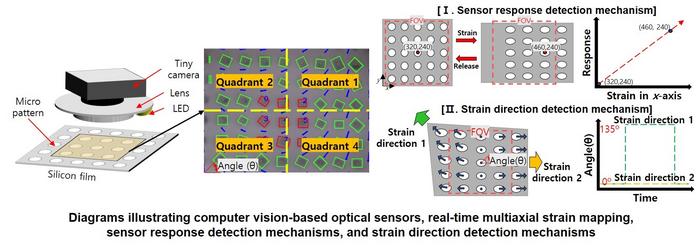Recently, a Korean company donated a wearable robot, designed to aid patients with limited mobility during their rehabilitation, to a hospital. These patients wear this robot to receive assistance for muscle and joint exercises while performing actions such as walking or sitting. Wearable devices including smartwatches or eyewear that people wear and attached to their skin have the potential to enhance our quality of life, offering a glimmer of hope to some people much like this robotic innovation.

Credit: POSTECH
Recently, a Korean company donated a wearable robot, designed to aid patients with limited mobility during their rehabilitation, to a hospital. These patients wear this robot to receive assistance for muscle and joint exercises while performing actions such as walking or sitting. Wearable devices including smartwatches or eyewear that people wear and attached to their skin have the potential to enhance our quality of life, offering a glimmer of hope to some people much like this robotic innovation.
The strain sensors used in these rehabilitative robots analyze data by translating specific physical changes in specific regions into electric signals. Notably flexible, these sensors are pliable and adept at gauging even the most subtle bodily changes as they are made from lightweight materials for ease of attachment to the skin. However, conventional soft strain sensors often exhibit inadequate durability due to susceptibility to external factors such as temperature and humidity. Furthermore, their complicated fabrication process poses challenges for widespread commercialization.
A research team led by Professor Sung-Min Park from the Department of Convergence IT Engineering and the Department of Mechanical Engineering and PhD candidate Sunguk Hong from the Department of Mechanical Engineering at Pohang University of Science and Technology (POSTECH) has successfully overcome the limitations of these soft strain sensors by integrating computer vision technology into optical sensors. Their research findings were featured in npj Flexible Electronics, the world-renowned journal.
The research team developed a sensor technology known as computer vision-based optical strain (CVOS) during their study. Unlike conventional sensors reliant on electrical signals, CVOS sensors employ computer vision and optical sensors to analyze microscale optical patterns, extracting data regarding changes. This approach inherently enhances durability by eliminating elements that compromise sensor functionalities and streamlining fabrication processes, thereby facilitating sensor commercialization.
In contrast to conventional sensors that solely detect biaxial strain, CVOS sensors exhibit the exceptional ability to detect three-axial rotational movements through real-time multiaxial strain mapping. In essence, these sensors enable the precise recognition of intricate and various bodily motions through a single sensor. The research team substantiated this claim through experiments applying CVOS sensors to assistive devices in rehabilitative treatments.
Through integration of an AI-based response correction algorithm that corrects diverse error factors arising during signal detection, the experiment results showed a high level of confidence. Even after undergoing more than 10,000 iterations, these sensors consistently maintained their exceptional performance.
Professor Sung-Min Park who led the research explained, “The CVOS sensors excel in distinguishing body movements across diverse direction and angles, thereby optimizing effective rehabilitative interventions.” He further added, “By tailoring design indicators and algorithms to align with specific objectives, CVOS sensors have boundless potential for applications spanning industries.”
Journal
npj Flexible Electronics
DOI
10.1038/s41528-023-00264-1
Article Title
Real-time multiaxial strain mapping using computer vision integrated optical sensors
Article Publication Date
10-Jul-2023




